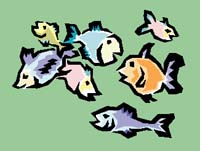
|
|
Environmental Ethics
There are many different meta-ethical perspectives available to someone viewing the world. These views range from completely focused on people to entirely centered around the planet and all of her inhabitants. A variety of different types of belief systems can be roughly fit on a continuum that spans the range from human to planet focused.
Work on the Habitat Conservation Plan for the Cedar River Watershed had to include input from many different sects of the community, most of which were listed as stakeholders under one or more than one of the nine primary issues we have discussed in other sections of this site. As one might expect, the stakeholders involved in this system cover the entire range of the continuum. What may come as a surprise is that several stakeholders can simultaneously hold more than one position. A few examples will be given to describe how this might work.
The primary stakeholders are the City of Seattle, the Muckleshoot tribe, Dept. of Ecology, National Marine Fisheries Service. Of these, the duty of the city might be the most complex. They have many responsibilities and must answer to many parties, which forces them to take a wide range views on the watershed. Because it is their responsibilty to provide water and power to the citizens of Seattle to insure that no one freezes to death or runs out of water to drink, they are required to take a very homocentric view of the resources made available by the watershed. Simultaneously, because they represent the citizens of Seattle, several of whom hold environmental health as a core value, they must also consider ecocentric viewpoints. In their representation of future generations, a deontological sense of duty to the unborn or very young. Because they own the vast majority of the upper watershed and must comply with the ESA if they are to provide the citizens with their utility needs, they must look at the entire system, not just one portion.
This requires a telological vantage on the system at large. All decisions must be based on the good of the whole, not necessarily on the decision in and of itself. For example, they have decided to build a fish hatchery for Coho in spite of the fact that it may not be the best thing for the wild Coho. When looking at the entire system they have come to realize that this non-native fish is a good compromise in terms of fish that may be caught for consumption and prefer to offer it up in lieu of a native, endangered fish. Finally, their responsibility to the financial department requires them to consider the utility of anything they do. Many detailed decisions must be born of cost benefit ratios, optimizing the use of available funding as it best suits the most people.
As you can see, it is a huge undertaking for one agency to meet the needs of everyone for whom it is responsible. It must often take many faces. This, however, can also be true for self-demanding parties as well. A good example of this is the Muckleshoot tribe. For the sake of survival of their people, rituals, and beliefs, they must be able to catch fish. However, this homocentric view bleeds directly into their deep-seated religious values that see the world as a system of which they are merely a part. Their very ecocentric belief system does not allow them to seem themselves as apart from nature and demands that they make all decisions based on what is best for the ecosystem. This ground undoubtedly becomes quite fuzzy when other groups of people, namely the City of Seattle, is inflicting much damage on the system that they were previously able to survive from and live in harmony with. When the system becomes sparce, something must give.
All of these complex and rich viewpoints are rolled together in varying degrees, colors, sizes and shapes to create a large political and social realm from which decisions must be made. It is not a simple or clean undertaking. There are often winner and loser, not always all human, not all with voices and not all well represented. It is a large balancing act. Fortunately, there are some tools to assist. The first tool is the establishment of laws that govern the land in a more general way. The second is the use of science to help make the correct decisions. Each will be further discussed. | |